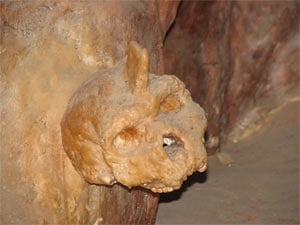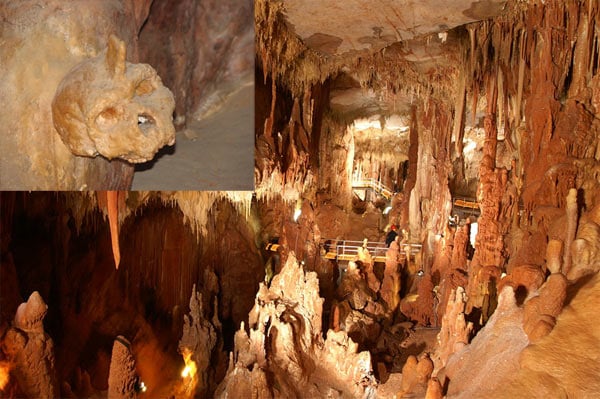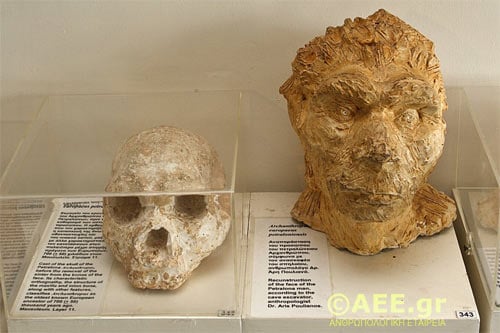The human skull that challenges the Out of Africa theory
This is the account of the discovery of a skull that has the potential to change what we know about human evolution, and a suppression and cover-up which followed.
In 1959, in an area called Chalkidiki in Petralona, Northern Greece, a shepherd came across a small opening to a cave, which became visible when a thick covering of snow finally melted. He gathered a group of villagers to help him clear the entrance so they could go inside and explore. They found a cave rich in stalactites and stalagmites. But they also found something surprising – a human skull embedded in the wall (later research also uncovered a huge number of fossils including pre-human species, animal hair, fossilized wood, and stone and bone tools).
 The skull was given to the University of Thessaloniki in Greece by the President of the Petralona Community. The agreement was that once the research was done, a museum would be opened featuring the findings from the Petralona cave, and the skull would be returned to be displayed in the museum – something that never happened.
The skull was given to the University of Thessaloniki in Greece by the President of the Petralona Community. The agreement was that once the research was done, a museum would be opened featuring the findings from the Petralona cave, and the skull would be returned to be displayed in the museum – something that never happened.
Dr Aris Poulianos, member of the UNESCO's IUAES (International Union of Anthropological and Ethnological Sciences), later founder of theAnthropological Association of Greece, and an expert anthropologist who was working at the University of Moscow at the time, was invited by the Prime Minister of Greece to return to Greece to take a position of a University Chair in Athens. This was due to the publication of his book, ‘The Origins of the Greeks’, which provides excellent research showing that Greek people didn’t originate from the Slavic nations but were indigenous to Greece. Upon his return to Greece, Dr Poulianos was made aware of the discovery of the skull at Petralona, and immediately started studying the Petralona cave and skull.
The ‘Petralona man’, or Archanthropus of Petralona, as it has since been called, was found to be 700,000 years old, making it the oldest human europeoid (presenting European traits) of that age ever discovered in Europe. Dr Poulianos’ research showed that the Petralona man evolved separately in Europe and was not an ancestor of a species that came out of Africa.
In 1964, independent German researchers, Breitinger and Sickenberg, tried to dismiss Dr Poulianos’ findings, arguing that the skull was only 50,000 years old and was indeed an ancestor that came from Africa. However, research published in the US in 1971 in the prestigious Archaeology magazine, backed up the findings that the skull was indeed 700,000 years old. This was based on an analysis of the cave’s stratigraphy and the sediment in which the skull was embedded. Further research in the cave discovered isolated teeth and two pre-human skeletons dating back 800,000 years, as well as other fossils of various species.
Today, most academics who have analyzed the Petralona remains say that the cranium of the Archanthropus of Petralona belongs to an archaic hominid distinguished from Homo erectus, and from both the classic Neanderthals and anatomically modern humans, but showing characterists of all those species and presenting strong European traits. A skull dating back 700,000 which is either Homo sapien or part Homo sapien is in direct conflict with the Out of Africa theory of human evolution.
Further excavations continued in the cave of Petralona with the participation of international researchers (46 specialists from 12 separate countries), which provided further proof of Dr Poulianos’ claims, including remarkable findings like fossilized pieces of wood, an oak leaf, animal hair and coprolites, which enabled accurate dating, as well as the almost continuous presence of stone and bone tools of the Archanthropus evolutionary stage, from the lower (750,000 years) to the upper (550,000 years) layers of sediment within the cave.
The research, after an interruption due to the dictatorship in Greece, continued up to 1983. It was then ordered by the government that all excavations at the site were forbidden to anyone, including the original archaeological team, and for 15 years nobody had access to the site or to the findings – no reason was provided by the government. Was this denial of access to prevent the extraction of whatever new scientific conclusions remained hidden within the incredible fossils embedded within the layers of the caves’ walls?
After the Anthropological Society of Greece took the case to the courts, 15 years later they were again allowed access to the cave. Since then the Ministry of Culture is trying in any way to overcome the Courts decision and further trials proceed.
 Dr Poulianos’ findings contradicted conventional views regarding human evolution and his research was suppressed. Dr Poulianos and his wife were physically attacked and injured in their home in 2012 and the culprits were never found. He and his team have been denied further access to the cave to complete their research and study, and the whereabouts of the skull is now unknown.
Dr Poulianos’ findings contradicted conventional views regarding human evolution and his research was suppressed. Dr Poulianos and his wife were physically attacked and injured in their home in 2012 and the culprits were never found. He and his team have been denied further access to the cave to complete their research and study, and the whereabouts of the skull is now unknown.
Today a sign sits outside the cave of Petralona stating that the skull found in the cave was 300,000 years old, and on Wikipedia today you will see references dismissing the evidence and trying to date the Petralona skull within acceptable parameters – between 160,000 and 240,000 years old.
Recently, Professor C.G. Nicholas Mascie-Taylor of the University of Cambridge sent a letter to the Ministry of Culture in Greece saying that the correct date of the skull is 700,000 years old and not 300,000. He has also challenged the government’s suppression of information regarding this incredible discovery.
The Greek Ministry of Education, Religions, Culture and Sports,
Bouboulinas 20-22,
Athens 106 82,
Greece
5 September 2012
Dear Sir,
I am writing on behalf of the European Anthropological Association, which is the umbrella professional and academic association linking all of the national European biological anthropology and human biology societies, to express our concerns about the conservation of the Petralona Cave and Skull, the misinformation of the dating of the skull, as well as the treatment of personnel associated with the conservation of the Cave.
The bases of our concerns are that the skull has been damaged through many scratches and the crown of a tooth (1st molar) cut off. As requested by Anthropological Association of Greece what is required is a detailed description of the present status of the skull, so that no one in future can arbitrarily damage it further. There is also the problem of dating which has been scientifically dated at about 700,000 years ago not 300,000 as is given at the information desk. There is a very detailed record of the excavations and findings which need to receive further public presentation but which have never been catalogued so as to prevent specimens going missing.
It is very unfortunate that the Greek Archaeological Department stopped Dr Aris Poulianos from further work in the Cave without any explanation. It is also very worrying that Dr Poulianos and his wife were physically attacked and injured in their home earlier this year and the culprits have not been found. He was also verbally abused when attempting to give an invited presentation to teachers and school children.
Senior anthropologists and geologists have also been denied access to the Cave and the specimens for further study on a number of occasions without substantive reasons. Earlier this year there has also been misinformation given to the Greek Parliament concerning financial aspects of the Cave.
I look forward to receiving answers to these questions.
Yours faithfully
Professor C G N Mascie-Taylor MA, PhD, ScD (all Cambridge), FSB, FNAS (Hungary)
Professor of Human Population Biology and Health and President of the European Anthropological Association
The most important conclusion of Dr Poulianos' research regards the co-existence of all main anthropological types (African – Kobi, Asian – Beijing and European – Petralona) at the same almost period (700,000, 500,000 and 750,000 respectively). That means: the appearance of the today human main populations (races or even better phyllae - from the Greek language and that’s why polyphyletic etc) is tending to almost 1,000,000 m.y.a. and not to only 10,000 or 30,000 years as currently considered world wide.
However, independently if there is a scientific dispute on the above, it is only sad to become aware that research is not allowed to those who are not coordinated to the “standard” knowledge, risking even their lives in front of gun shooters.
Is this a cover up of an incredible discovery that the powers-that-be do not want us to have access to? You be the judge.
Update from editor 31 December, 2018: Dr Poulianos wrote to Ancient Origins to state that unfortunately the suppression of information regarding the Petralona skull has continued:
“Experiencing the above I am asserting that the prohibition of research regarding human history is due to the following (most obvious, i.e. not exposing political) reasons:
Various (Worldwide) Universities and their state allied forums have the power to influence all of the small range national institutions in order to achieve the aforementioned prohibition. In turn, this is most probably due to the fact that such research is allowed only to some “confidential” persons. Thus, re-righting chapters of human history is only their “right”. Whoever does not belong to such clubs and / or forums has to be stopped by all existing means, even by falsifying the truth against well documented evidence (i.e. without providing any scientific contradicting argument). Obviously I am asserting that knowledge is under control, especially what concerns human history. Therefore I agree with Lenie Reedijk’s description regarding the “Cover Up”, as well as the following comments to her article.”
By John Black
Related Links
The 40th Anniversary since the discovery of the Petralona Archanthropus' skull
The significance of the fossil hominid skull from Petralona, Greece
Related Videos



















Comments
When you consider the broad standard deviation of modern human skulls, the question becomes, are THEY that dumb to try to create new theories from one or a few ancient skulls, or are we that dumb that they think we’ll believe it?
Nobody gets paid to tell the truth.
When I was a lad I bought and read "Phenomena" a large paperback that went with me wherever I went and is almost certainly the basis and raison d'etre of this website that owes its entire subject matter to what that book listed 40 years ago.
We have all been here a very long time, much much longer than science supposes, and we are only now beginning to scrape at the surface of our planet in the search for when and where we began to be ourselves.
The book has a number of photographs in it you wont see now. But occasionally a copy of the book turns up online. Well worth its cost
One photograph showed clear fossilized imprints of human beings in the same river mud in Arizona as the dinosaur footprints alongside it.
Perhaps film and photography is better than words are after all?
After spending an enormous amount of time wadng through the comments and responses posted here, I am impressed with a few, and disappointed with many. Somehow the pertinent facts of the article seem to be appropriated by many to espouse some some sort of racist, egocentric position, thereby missing the most important part.
That is the suppression of evidence, artifacts, and data that is at odds with current accepted theory. The Spanish destruction of Mayan records and artifacts 500 ya could possibly be attributed to ignorance, but in our present age, similar actions are inexcusable. Witness the claim of ‘improper’ excavation methods used to try to stop the investigation of the antiquity of Gunung Padang.
To my mind, this suppression is absolutely criminal, but to my knowledge, none have ever been prosecuted for concealing or burying information. Let them protect their grants at the risk of being prosecuted for perjury or obstructing truth – should be as valid as obstructing justice.
I must admit that I did not read all the above comments, but I would like to add, that it is my perception, that there are certain "centers of influence" in archeology, history and teaching that wants to impose their theories on history, regarding the origin of humans, to preserve the indoeuropean theroy (meaning with that we are all equal - no nation is different or better - we are all related), why not accept a theory that says that life began in different places on earth, and evolved parallel, and that it was not the sumerians that discovered, the wheel, agriculture, writing etc etc.
It all comes down to one thing, namely those who control what theory is the one that must be aknowledged, is the one that supports, those who want to prove, who was here first. What I am trtying to say, and forgive my bad english - is that if skeletona were found in Greece for example, that could prove that the Greeks were αν indigenous population, there right to anhabit certain geograpic places could not be questioned, and vice versa, if you find arceological findings in another country that could be related to your people, you could make claims.
The indoeuropean theory is onl;ly based on Linguistic theoris, beginning from an english lawyer in India.....
As I read these comments, I find that people in general are stupid no matter their IQ. There is fact in all comments and thoughts, no one person is absolute in their opinion, whether scientist or a genius civilian. The problem with humans all, is hubris, greed, notoriety, position of influence, or the search for position of influence. Basically, power corrupts fully, whether it be in the Catholic Church, or in the 7/11 store in your neighborhood. The quest to be the best and make the most money, corrupts humanity fully. Until humans learn to live in peace, less a pyramid of power, then the truth on all levels of humanity will never never known. Opinions do not necessarily a hater make. The act of hate makes the hater.
Pages